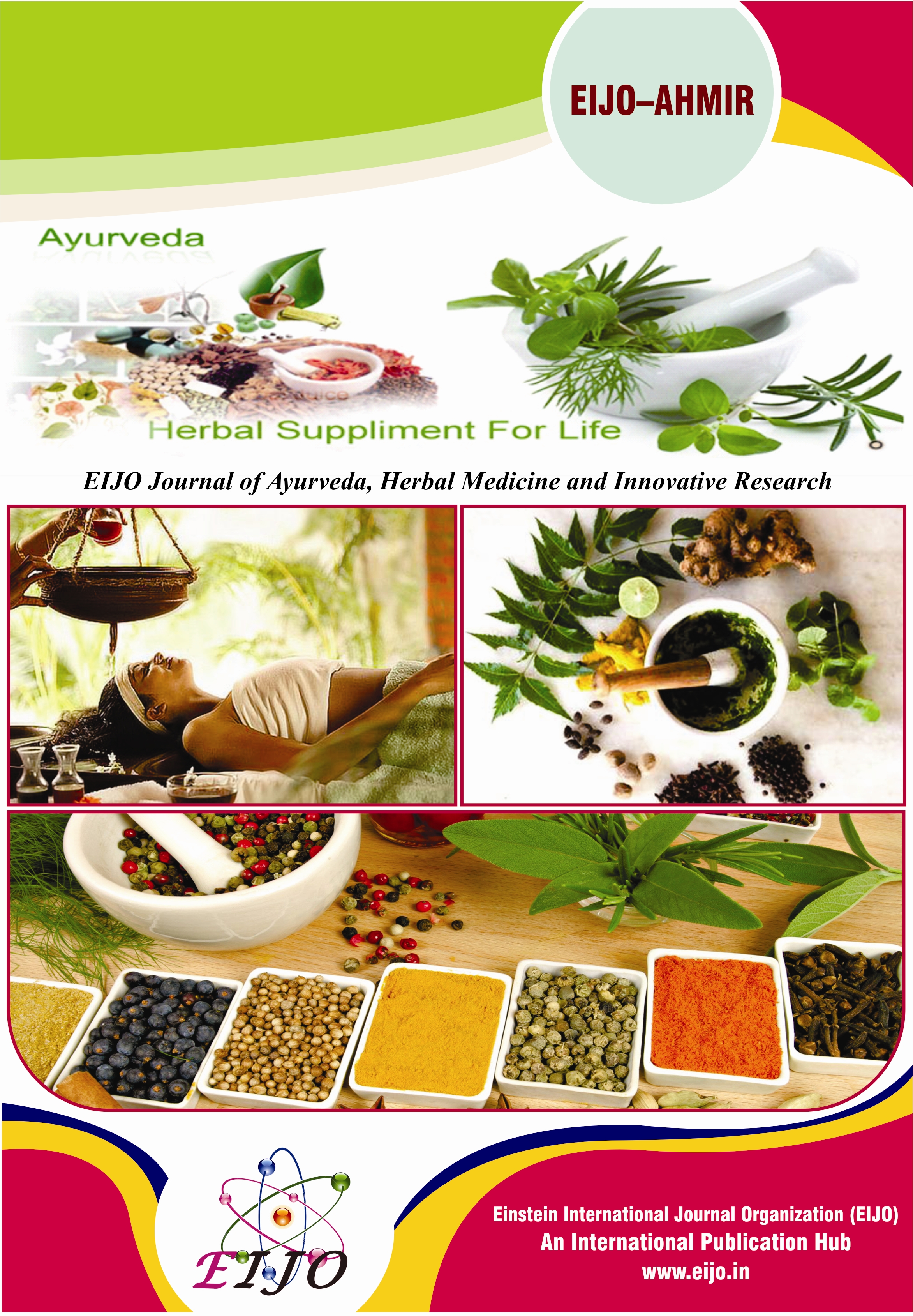JOURNALS || EIJO Journal of Ayurveda, Herbal Medicine and Innovative Research (EIJO – AHMIR) [ ISSN : 2456 - 530X ]
Abstract
Ayurveda means “ The Science of Life” Ayurvedic knowledge originated in India more than 5000 years ago and is often called “Mother of all healing ”..Rasashastra, the ancient alchemical science, a branch of Ayurveda originated with the twin aim of attaining Deha Siddhi and Loha Siddhi.Classified in Maharasa,Uparasa, sadharana rasa ?Dhatu (Metals).Ratna,Uparatna and Sudha Vargas for the preparation of medicines from the metals and minerals different procedure like shodhana, marana Jaran,Murchana metioned in Rasashastra.There are eight sadharan rasa (group of minerals) mentioned in Rasa-Shastra. Kampillak a drug of herbal origin has categorized as one among them. It is ‘Phalaraja’(Glands and hair of the fruits) obtained from the plant Mallotus phillippinensis muell. Although it is a herbal drug because its usefulness in ayurvedic mercurial preparation (rasasiddhi) it is included under sadharana rasa.It is observed that the drug is used in 44 formulation indicated in Krimirog(worm infection),Twacha rog(skin disease),Shula,Shleshmodara,Premeha etc. Useful part of the plant is Phalaraja and should be administered internally after passing through shodhan (purification) process.The branch Bhaisajya Kalpana plays a key role in manufacturing field by providing rational basis for proper selection utilization and processing of the drug.It bridges the gap between basic medical science and clinical medicine. An anti microbial is an agent that kills micro organism or inhibits their growth. The use of anti microbial medicine to treat infection which kills a wide range of microbes on living surface to prevent the spread of illness. The process which is ment to remove the dravya doshas is called as shodhana. An attempt is made to purify Kampillaka and study its anti microbial activity against Gram positive bacteria Staphylococcus aureus,Bascilus Substilis and Gram negative bacteria E.coli & Sallmonella Typhi. Kampillaka is cheap & easiy available in market. Ayurveda have mentioned many properties of it. While using that particular drug some properties of it may remain unfocused during gradual development of this science. Krimighna property of Kampillaka can be considered as such one which should be focused while doing research. Thus the present study is used to highlight the comparison of antimicrobial activity between 2 different formulation of kampillaka i.e kampillaka oil & kampillaka malhara
Keywords: Mallotus Philippensis,antimicrobial ,E.coli,Salmonella typhi,S.aureus,B.Substilis
[1].Charak Samhita commentary by Chakrapani edited by Vaidya Yadavji Trikamj Acharya,Varanasi,Chaukhamba,Sanskrit Sansthan,1994(Kalpasthan12/104)
[2]. Sushruta(2005),sushruta samhita, with commentary of Dalhana, Ed. Yadavji Trikamji,sutrasthana, 45th chapter/ 112, chowkambha orientalia varanasi.
[3]. Vruddha vagbhata (2007), Ashtanghahrudaya, translated by BrahmanandaTripati,5thChapter/55-56 chaukhamba Sanskrit pratisthan, New Delhi.
[4]. Dhanvanthari Nighantu(2005), Ed. P.V.Sharma and Guruprasad Sharma,chaukhamba orietalia varanasi, pp 124-125.
[5]. Vagbhattacharya (1998), Rasaratna samucchaya, Kampillaka, 3rd chapter/126, Ed. Kapildeogiri, translatedby IndradevaTripati.Chaukhamba Sanskrit bhavan varanasi. pp 37
[6]. Madhanapala nighantu (2010),Abhayadivarga, 1st chapter/ 110 Ed. JLN Shastri, chaukhamba orientalia varanasi,pp 80.
[7]. Dhanvanthari Nighantu(2005), Ed. P.V.Sharma and Guruprasad Sharma,chaukhamba orietalia varanasi, pp 124-125.
[8]. Bapalal (1998),Nighantu Adarsha, 1stvolume, India:Chaukambha bharati academy varanasi, pp.448.
[9]. Bhavamishra (2000), Bhavaprakasha, Ed.vidyotini hindi commentary by Brahma sankara Mishra, krimi chikitsa, chaukambha Sanskrit sansthan varanasi.pp 97
[10]. Rasa Tarangini, Pandit Kashi narayaran Motilal Banarasidas Publication, 11th edition .1979, Page no.22.
[11]. Rasaratna samucchaya translated by Dr.A.D.Satpute Chapter no.8/55Chaukhamba Sanskrit pratisthan Delhi page no.192.
[12]. Ayurvediya Aushadikaran Part I, Dhamankar –Puranik Dhootpapeshwar Publication, 2nd edition, Page No.103.
[13]. Bhaisajya Ratnavali English Translation By Kanjiv Lochan Commented Upon By Vaidya Shri Ambika Datta Shastri Vol.1.
[14]. Sharangdhar Samhita Madyam Khanda Sanskrit Text With English Translation By Dr. Prabhakar Rao Chaukhamba Sanskrit Sanastan Varanasi.Chapter 9/7 Page 160.



